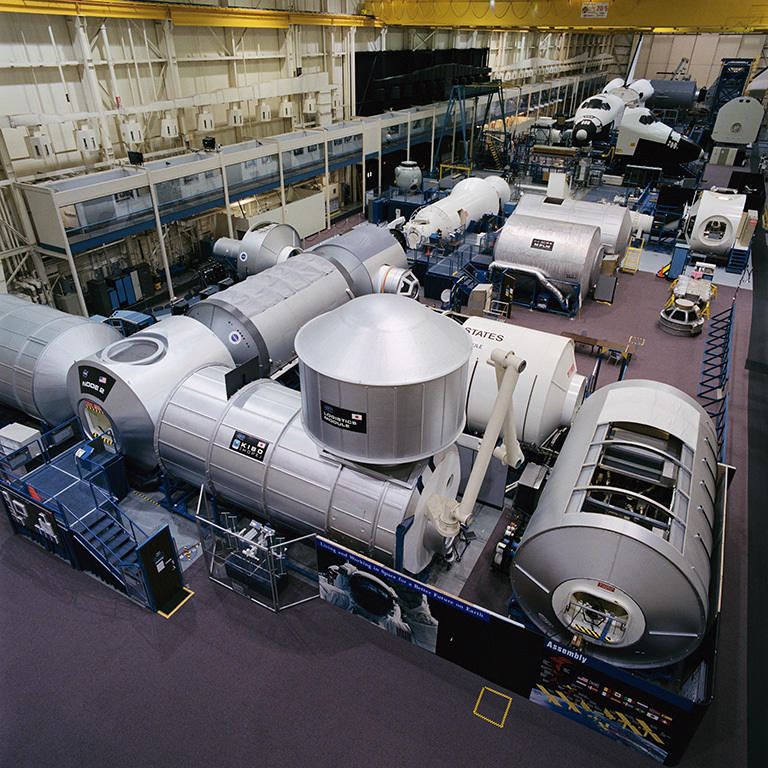Ask NASA Climate | October 31, 2016, 13:21 PDT
NASA, psyched about sustainability
On Earth, on Mars and everywhere in between

Johnson Space Center's Space Vehicle Mockup Facility. Photo courtesy of Space Center Houston.
Rockets, rockets, rockets. Space ships, too. We’re NASA. And yes, we launch fancy tech stuff, and burn rocket fuel in the process. Yup, we do.
Oh yeah, we have a bunch of aircraft as well, so add plane fuel to that.
True, we do launch spacecraft and we do fly modified aircraft, but if you believe that’s all we do, then maybe you didn’t know about the huge role NASA plays in greenhouse gas mitigation, environmental stewardship, and partnering and planning for sustainability.
I mean, when most people think about the International Space Station, the first thing that comes to mind is floating and flipping around in zero gravity, not the fact that the ISS is an off-the-grid, self-contained environmental ecosystem with a core principle of conserving resources. It’s a real test-bed for learning how to live sustainably.
Think about it: For astronauts at station or on a journey to Mars, recycling water is required!
And scientists and engineers are also people, so our way of life has an impact on the environment we study. This means that the same person who remembers to use both sides of a sheet of paper and be less wasteful might also be the same person responsible for purchasing a big polluting thing like a generator. “The daily habits we practice here — the behaviors, the teams, thinking about the process before you start — get people in the mindset to develop a system for sustainability,” Walker said. See, some of NASA’s buildings are large and power hungry, especially the ones that house those spaceships. Earlier that day, I’d been romping around in the Space Vehicle Mockup Facility, a huge beast of a building that houses the Space Station and Space Shuttle trainers, Orion landers, and oodles of robots and robo-vehicles. That building must be a monster to keep cool, dry, lit, etc.
“We operate a central plant with boilers, which are a source of greenhouse gases. If we buy the one that pollutes less,” Walker explained, “then whatever plant I’m operating, the cleaner I can do it, the less overhead. And 10 years from now, when the rules tighten up, we’ll still be able to use the same generator.”
“Part of it’s psychological,” Walker continued, “the soft side to environmental stewardship that’s as important as the permits, and the power grid, and the energy efficient generators.” For example, the astronauts’ favorite part of the ISS is the cupola because it has all the windows where they can watch the Earth. It’s the same reason people prefer a glass front for offices: so you can see outside.So managing a NASA facility and learning to promote energy conservation is great practice, regardless of whether we’re planning for a future on Earth or on a 2.5- to 3-year journey to Mars.
Shutts compares her view of sustainability with ethics. “We can’t introduce microbes to Mars. Then all of our future research would be contaminated and we’d impact it for future people who will come to Mars. In the same way,” she continued, “if we use all the resources here, then they won’t be there for the next people. If you’re thinking in a lifecycle sense or in a long term range for your business or your organization, you have to plan for the next centuries ‘cause we want to be around longer than that.”And yes, at NASA, we do want to be around longer than that.
Thank you for your comments.
Laura
Walker’s sustainability management approach also focuses on areas of energy and water reduction, green purchasing, reducing the generation of hazardous waste and increased diversion from landfilling of waste through recycling initiatives. Under Walker’s direction, the JSC constructed eight certified green buildings that use 100 percent green power and average 35- to 40-percent reductions in energy and water consumption of comparable facilities. With Walker’s leadership, JSC has reduced potable water use by 15 percent annually, or more than 60 million gallons per year, since 2009, and over the past two years has composted more than 85,000 pounds of food waste.
